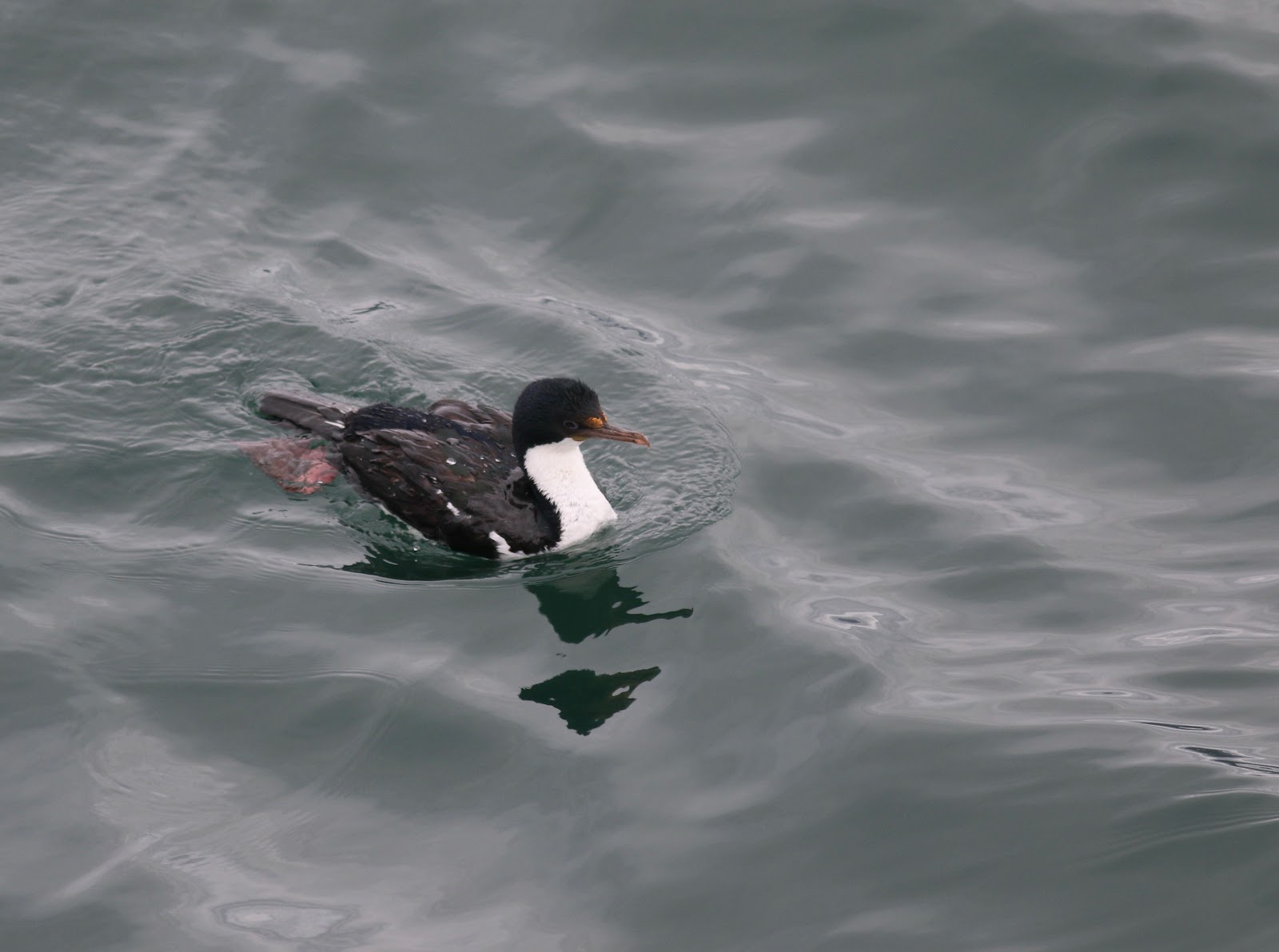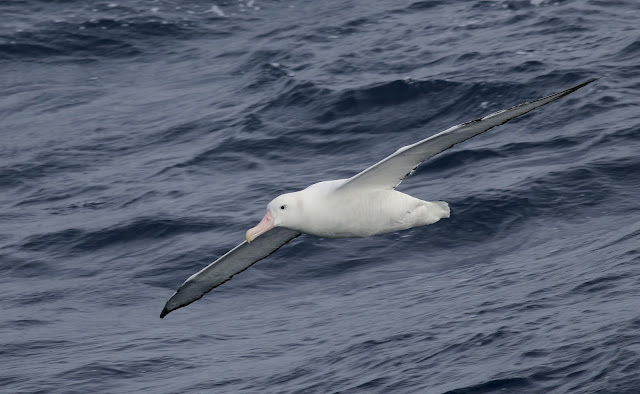One of the themes of this trip was that it was very hard to stop birding with the increased amount of daylight hours and the potential for lifers everywhere I looked but in my cabin. So once we docked in Ushuaia and most people were settling in, I dropped my stuff in the cabin and went on deck to bird the harbor. We weren't allowed off the boat but I was able to Geri-bird the dock.
Dolphin Gulls are super swanky.
Brown-hooded Gulls are reminiscent of Black-headed Gulls and are in the same family - Chroicocephalus.
I will spare you the photo of the Blackish Oystercatcher fly-by. It basically looks like a Black Oystercatcher from the Northwest USA. You would think they could come up with a more imaginative name. Might as well call them Somewhat Black Oystercatcher.
We also had some Rufous-chested Dotterels that Matt picked up on a far mud bank with his scope. Don't worry dear readers, we got closer looks on the way home.
Imperial Shag
Kelp Gull
It didn't take long for us to leave the harbor and start motoring out the Beagle towards the infamous Drake Passage.
I still could not get over the crazy amount of Black-browed Albatrosses. They were simply everywhere.
27 Albatrosses in one shot!
Southern Giant Petrels
Presumed Humpback Whale - One of the funny things about the 10 days on board the ship, if you waited 10 minutes on deck and looked carefully, you would find a whale. However, somehow there were quite a few people on the ship that told me they hadn't seen any whales.. That's the thing about these Antarctica trips, many people are simply on board so they can check a box for the seventh continent and did not spend much time outside.
Our buddy Steve B whom we knew from NC pelagic trips was working for Lindblad as a naturalist on the boat which was awesome because he gave us tips here and there. One of them was to look out for a Magellanic Penguin colony on the way out the Beagle Channel for a lone King Penguin hanging out on the beach. Apparently when penguins are molting they just have to sit tight wherever they are until they are done. Steve had seen a King Penguin on this particular beach over a week prior. King Penguins are common in certain areas away from where we would be and we knew this might be the only one of the trip.
It was easy to find the colony, and it blew me away how these jokers climb the steepest cliffs to hang out when the grassy knoll on the left seemed easy in comparison. Perhaps they are safer on the more treacherous terrain although I don't know what would eat them.
Here was the beach below the cliffs, so we began looking for a larger penguin. As you can see the beach was super far.
I couldn't believe it, but Matt picked it out with the scope. Look for the larger penguin in the center of the frame in back of the Kelp Gull. If you blow it up you can just make out the orange color at the top of the breast. Pro-tip: scopes work on big cruise ships. I am not sure if I would have brought mine anyway as I like to be light on my feet. However, when Matt pointed in the general direction I snapped a bunch of photos and somehow was able to pick it out. I will definitely want to go back to these parts for a better look but that was the only King Penguin of the trip.
After that the light started to fade and Matt and I headed to dinner which was a preview to the awesome meals I would have every day for the next week and more. The meals were all made personal probably because buffets were still restricted due to COVID. That suited me fine because otherwise I would have really gained a ton of weight. The chef on the boat was awesome and made some really inventive and tasty creations. Then the other huge bonus was the free drinks.... I tried my best to keep it to 2-3 drinks a day because I wanted to stay sharp and definitely didn't want to get sick. But it was nice to be able to order good cocktails, beers and wine whenever I wanted it.
On the first morning in the Drake Passage, I woke a little queasy with the rolling of the ship in the big swell. So it was a bit of a challenge to get breakfast in me but once I made it on deck with some fresh air, I never was queasy again for the whole trip. Pro tip #2 - the secret to never getting sick on a boat is to spend as much time on deck as possible until you have your sea legs. Knock on wood, but I have only thrown up once on a boat and that was over 25 years ago on a cod-fishing boat off the coast of New York in the middle of winter. That trip was enough to make me never want to get sick on a boat again.
Northern Giant Petrel looking like Gonzo. The birds in the Drake Passage were not plentiful but they were good birds and it was fun watching them zip around in the wind and the waves. The trip across the Drake was for over 24 hours and never turned out to be gnarly like the Drake can get. I almost was disappointed that we only had moderate swell and wind.
Now a bit on Albatrosses, they can be tricky in these parts in certain plumages. That is why I love photographing birds, you can study the pics later whereas making a call in the field for a bird species you have never seen before is a dicey proposition.
Both Wandering and Royal Albatrosses (Northern and Southern) can have somewhat solid black wings so at a distance other factors must be weighed. Unfortunately this particular one didn't come closer. The tail looks to have black on the end which would make it Wandering in that plumage (young bird) but that could just be the feet projecting past the tail. I believe this is a young Wandering but no worries I got better looks later at all three species.
This older Wandering Albatross came in much closer and followed us for some time as the species is known to do. It's older because the wings have more white on them. It's a Wandering because it has the diagnostic ear patch that looks like it's smudged with ear wax. Also, the bill is close enough here to see there is no dark black dividing line which would make it one of the Royals. The tail is all white which is normal for an older bird.
A penny for your thoughts! I bet this guy/gal has seen every corner of the southern oceans. Some of these birds regularly circumnavigate the globe in a short amount of time.
The largest wingspan of any bird at 3.5 meters!
So one of the interesting things about birding from these large ships is you get different species depending on where you position yourself. The large Albatrosses seem to come up the wake from the rear, but other species that tend to rest on the surface of the water are best seen up at the bridge where they flush from the bow.
Here is one of those species. This was a Magellanic Diving-petrel which we never got great looks at. When they flush you only get a couple seconds before they fly away and disappear. This picture was taken through the bridge glass.
I was able to call it to species because the white extends around the back of the eye and to the nape. Three hours late and further out in the Drake, we picked up this one....
Common Diving-petrel - the face was all dark with no white wrap-around in back of the cheek/nape.
I hope to have better looks at these closer to the South American shore when I go back someday. I would love to do the Falkland Islands and explore more of Chile and Argentina.
Orcas! For the sea mammal enthusiasts on board, they get really excited and can tell what sub-species or grouping of Orcas we are looking at. Someone said something about this pod, but I can't remember what.
It's interesting that when we saw pods of whales or killer whales, we usually saw more bird activity so I would easily get distracted.
Our first Grey-headed Albatross! This was one of my favorites of the trip.




























Type D Orcas! Certainly the rarest species we saw on the trip. First live observation was less than 20 years ago.
ReplyDelete